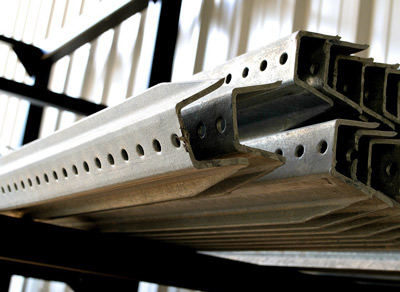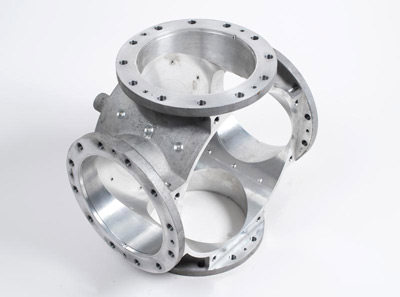The textbook difference between ferrous vs non-ferrous metals is the presence of iron; ferrous metals are those made of or from iron, while non-ferrous metals are those that do not contain iron. The word ferrous is derived from the Latin ferrum, meaning “iron,” and like copper and bronze, the word not only denotes a metal widely used today on an industrial and commercial scale but also an Age of Humanity, with all three marking the advent of civilization. The discovery of copper and its applications 7,000 years ago ended the Stone Age and commenced the Copper Age. In time, combining copper and tin together led to the discovery of what an alloy is, and the Bronze Age followed. Around 1200 BC, the production of iron ore became widespread and we entered into the Iron Age.
Today, the use of these and other metals are commonplace, but the usage and applications of ferrous and non-ferrous metals are distinct and well defined.
What Are Ferrous Metals?
 Ferrous metals are simply those that contain iron. The most common ferrous metals are cast/wrought iron, carbon steel, alloy steel, and stainless steel. Iron predates steel by hundreds of years. Steel is an alloy, invented by adding iron and carbon together. Tensile, ductile, durable, and strong, iron is a heavy but soft material, with high thermal conductivity. However, for the most part, in terms of usage, iron has been replaced by its offspring, steel, which is a far harder metal.
Ferrous metals are simply those that contain iron. The most common ferrous metals are cast/wrought iron, carbon steel, alloy steel, and stainless steel. Iron predates steel by hundreds of years. Steel is an alloy, invented by adding iron and carbon together. Tensile, ductile, durable, and strong, iron is a heavy but soft material, with high thermal conductivity. However, for the most part, in terms of usage, iron has been replaced by its offspring, steel, which is a far harder metal.
On a global scale, structure steel is possibly the most widely used material by engineers and in construction. It’s used for the tallest skyscrapers, the biggest ships, and spans the longest brides. Ferrous metals are used in the making of automobiles, trains and the railroad tracks they roll on, frying pans, parts for durable goods, shipping containers, industrial piping, fencing, nails, and tools and tooling, to name a few. With the exception of wrought iron, because of its purity, and stainless steel, because it’s at least 10% chromium, ferrous metal’s weakness is rust and corrosion when exposed to the elements. It should be anodized if it is to be exposed to the elements. On the other hand, ferrous metal is magnetic, which not only makes it ideal for sorting and recycling scrap, but perfect for attaching postcards and grocery lists to refrigerator doors.
Ferrous Pros
- High tensile strength
- Durable
- Ductile
Ferrous Cons
- Easily rusts
- Easily corrodes
- Magnetic
- Can generate a spark
What Are Non-Ferrous Metals?
 Conversely, non-ferrous metals are those that are free of iron. Copper, aluminum, nickel, zinc, tin, are prime examples, as are precious metals such as gold, silver, platinum, and palladium. The main advantage in the use of non-ferrous over ferrous materials is their lighter weight and malleability. With very little, or no iron content, non-ferrous metals have higher resistance to rust and corrosion. Because of their non-magnetic properties, they are ideal for wiring and every conceivable electronic gadget, and all other types of conductive applications. They are also used in flammable and explosive environments since they cannot generate a spark.
Conversely, non-ferrous metals are those that are free of iron. Copper, aluminum, nickel, zinc, tin, are prime examples, as are precious metals such as gold, silver, platinum, and palladium. The main advantage in the use of non-ferrous over ferrous materials is their lighter weight and malleability. With very little, or no iron content, non-ferrous metals have higher resistance to rust and corrosion. Because of their non-magnetic properties, they are ideal for wiring and every conceivable electronic gadget, and all other types of conductive applications. They are also used in flammable and explosive environments since they cannot generate a spark.
For instance, aluminum is lightweight, and can be easily cast, forged, machined and welded. Aircrafts are manufactured by aluminum casting, as are fenders, frames, pistons, radiators and like parts found in and used to construct autos, trucks, boats, and bikes. Copper is ductile and malleable it is used in sheet roofing, bearings, pipes, and statues. Its high conductivity makes it the principal metal used in electrical castings in the form of wire and other conductors. Zinc is most widely used to galvanize protective coating of iron or steel to prevent rust.
Non-Ferrous Pros
- Corrosion-resistant
- Rust-resistant
- Lightweight
- Malleable (better for precision casting)
- Non-magnetic
- Will not generate a spark
Non-Ferrous Cons
- More expensive for very large castings
- Lower tensile strength
Patriot Foundry is a leader in the non-ferrous castings industry, offering a range of services from sand casting to prototype casting and more.














